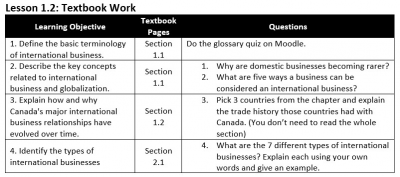Lesson 1.2 - International Trade
Learning Goals:
By the end of this lesson you will be able to...
1. Define the basic terminology of international business.
2. Describe the key concepts related to international business and globalization.
3. Explain how the global market has affected consumer demand
4. Identify the types of international businesses.
5. Explain how and why Canada's major international business relationships have evolved over time.1. Would you rather work for a domestic or international business? Why?
2. Name as many international businesses as you can. Pick 1 and explain how it is international.Independent work
- Textbook work (Read Chapt 1 and Chapt 2 PDF below)
- Glossary quiz
- Exit Card
- Homework -Note book
- Lesson notes-Note book
Students are required to write their lesson notes and homework in their notebooks every day. Completing this task daily will earn you a bonus of one mark."
Do the textbook readings and then do this quiz before class.
- Study the glossary and then do this quiz before class.
Why are domestic businesses becoming rarer?
What are five ways a business can be considered an international business?:
Pick 3 countries from the chapter and explain the trade history those countries had with Canada.:
What are the 7 different types of international businesses? Explain each using your own words and give an example.
- 1. Review: What's the difference between tariff and import quotas? When do we use which?
2. Thinking: Is a small local convenience store in your neighborhood a domestic or international business? Explain.
3. Application:Canada’s Trading Partners
• Students will be put into small groups. Each group will be assigned one trading partner
• Students work in groups to create a short presentation talking about why Canada trades with that country.
• Each group presents to the class Do this quick survey to let the teacher know how to support you in your learning.
